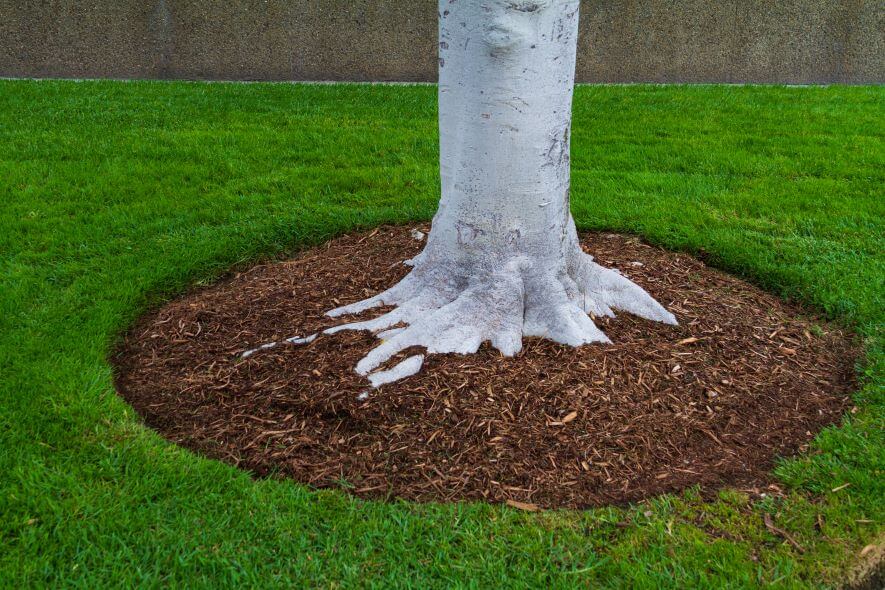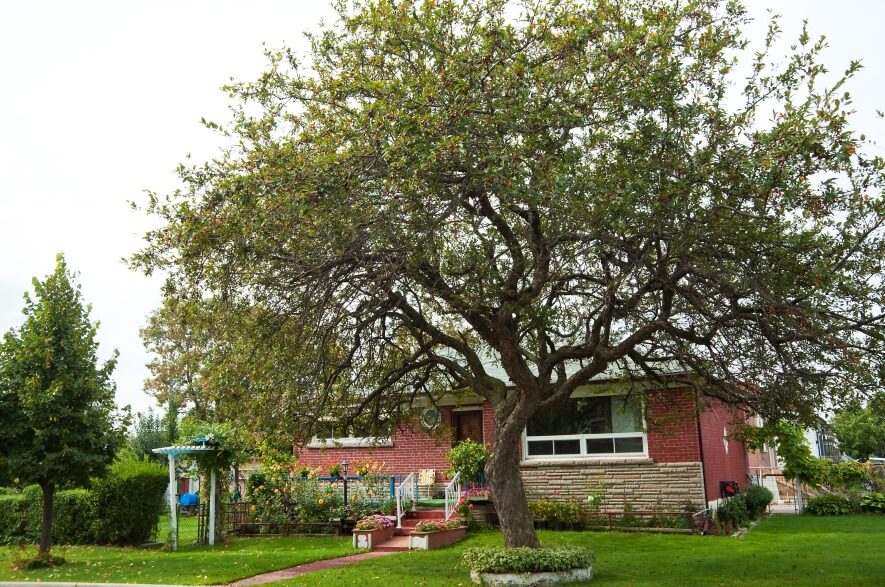That leafy green tree in your yard made you fall in love with your home. It offers beauty, shade and possibly even savings on your energy bill. But there are some downsides: You need to watch out for branches that could tumble down in a storm, for example, or roots that could crack concrete.
Fortunately, you can often spot potential tree problems before they occur. Proactively inspecting and caring for trees may keep them around longer, protect your home and keep your family safe. Here’s what you need to know about basic tree maintenance and how to work with a qualified tree care company.
Learn to Spot Signs of Tree Trouble
Any homeowner can learn the telltale signs of a tree problem. For starters, it’s a good idea to walk your property regularly and inspect the top, middle and bottom of your trees, says Tchukki Andersen, staff arborist for the Tree Care Industry Association.
Here are some potential signs of trouble in each part of the tree. These issues may be caused by storm damage, pests or diseases:
Canopy
- Broken or dead branches
- Holes or chew marks on leaves
- Leaf discoloration

Trunk
- Cracks in the bark
- Holes in the trunk
- Discoloration
- Mushrooms growing on the trunk

Base
- Soil lifting or heaving
- Cracked roots
- Roots causing damage to a home, shed or other structure

For your own safety, note any signs of wildlife in a tree before cutting dead branches or doing other work. “If there’s a bee’s nest, you’ll want to find it before you cut away the branch it is on,” Andersen says. “And raccoons, squirrels and rodents move around in the canopy and could bite if provoked or frightened, especially if there’s a nest of young ones in your work zone.”
Also look for any steel support cabling that has snapped or electrical wires that may be sagging into the top of a tree. “There are things you can do on your own to look for any red flags or risky situations,” Andersen says. However, before you act on these situations, you’ll want to make sure it’s safe for you to do so. If not, you may want to call in a tree care professional for help.
How to Maintain Trees and Prevent Problems
Even if you don’t spot any obvious issues, it’s a good idea to hire a qualified professional for regular tree care. Getting your trees checked regularly and addressing issues right away can help you prevent costly—and potentially dangerous—problems down the road, Andersen says.
A tree care professional can provide regular inspections, tree pruning and treatment for problems that may arise. A tree care company may be able to:
- Treat a tree with pesticides or naturally-based products for wood-boring or other insects
- Boost populations of beneficial insects to reduce pest populations
- Fortify soil to promote tree health
- Redirect or prune roots to encourage them to grow away from a home, a walkway or an in-ground swimming pool
- Prune or thin out a tree canopy over a roof to encourage air circulation and prevent moss growth or moisture damage
A tree care professional will tell you how often your trees need to be inspected. They may also give advice on how to head off future tree issues. “They might say, ‘Five years from now, this cherry tree is going to be kicking up shingles on the roof,'” Andersen says. “‘But we can mitigate that with some pruning or growth regulator right now.'”
The key to preventing big problems (like a tree ruining your roof, damaging your foundation or falling on your home) is to catch issues early.
Should You DIY Tree Care or Hire a Pro?
When it comes to tree maintenance, some tasks are DIY-friendly, including watering your trees. You should do this once a week for half an hour if your area is not getting much rain, Andersen says. This helps promote good structural growth and keep trees firmly rooted. Andersen explains: “That goes a long way toward maintaining tree health, and it’s something anybody can do.”
Some homeowners may also be able to handle minor pruning on small ornamental trees such as pear trees or redbuds, according to Andersen. “If there are broken or dead branches in these smaller trees that you can reach from the ground with a handsaw or pruners, then you may be able to go out and do it yourself,” Andersen says.
But bigger jobs should be left to the pros. This includes tree removal, which should only be performed by a qualified and insured tree professional. Even regular pruning is often best left to a tree care company.
“To shape or direct future growth, an expert eye is needed,” Andersen says.
Maintain Your Trees to Maintain Your Coverage
Maintaining your trees is a smart move from an insurance standpoint. For example, you may need to address a dying tree or branches that are touching your roof to keep insurance coverage affordable.
If your insurance company spots a potential tree danger, they may reach out to ask you to fix the problem within a certain timeframe. And if you don’t, they may raise your premium or decide not to renew your coverage, says Loretta Worters of the Insurance Information Institute.
That’s because trees can pose a variety of dangers to your home. For example, branches scraping a roof can lift shingles, causing water damage or mold issues. An electrical wire touching a tree could spark a house fire.
“It’s an important area insurance companies look at because they’re insuring the potential risks of something happening to your home,” Worters says.
Letting tree problems go unchecked can cause major property damage, injuries or death. In a worst-case scenario, a tree that’s rotten or weak can fall—either a branch or the entire tree, says Nick Gromicko, founder of the International Association of Certified Home Inspectors.
“Trees fall on people, homes, cars and everything else,” he says. “A mature tree is thousands of pounds of wood, hanging right over people’s heads.”
Taking Care of Trees for Savings and Peace of Mind
With the proper maintenance and help from a qualified tree care professional, you should be able to predict, prevent or delay many problems.
Every homeowner should learn to monitor the trees on their property and look for problems on their own. You should also develop a good working relationship with a trusted tree professional in your area. This approach may help you to keep your trees healthy, prevent tree-related property damage or injuries and avoid tree issues that could impact your insurance coverage.
While it’s an area many people don’t think much about when planning home maintenance tasks, it can really pay off to give regular attention to your trees.
Have you headed off tree trouble by maintaining the trees in your yard? Please comment and share your best tree maintenance tips for other homeowners, or your stories about the troubles tree maintenance has saved you.
Read more – Home Landscaping Do’s and Don’ts







First when we buy a home we check, don’t want a stream, river or lake that could cause damage do to unexpected rain amounts. Also we check house location raised so no water build up possible. We evaluate size and position of trees. We have been here 17 years and three trees finally grew tall enough to reach house & damage. Located west side of house where wind comes from. We cut them down in 2022 they could reach our house “extremely dangerous”
In Florida, you must have an official sign-off to remove even dead branches over your home. Many trees such as the Oak, are protected in Florida. What right does the homeowner have over the city code when there is potential damage to the house or the garage structures?
Tree owners should be mindful of tree branches and limbs hanging over fence lines into their neighbors yards messy leaves everywhere trees should be confined to your own yard! keep trees cut back at least once a year.
Any overhang on my property, I remove and pay for.
I am a retired landscape designer who went to school to learn my skills. Although I am retired, I maintain all my own trees, but occasionally need help from a younger crew. I find that regularly observing and pruning my trees makes them more beautiful, healthy and easier to maintain. I do some pruning annually in the spring and fall. Keeping this schedule makes their maintenance easier and more trouble free.
I am a landscape professional who has formal schooling. I am (retired).
What can I do about a neighbors tree that it’s trunk is about 18” from my fence and a lot of it hangs over my property causing me issues?
We do most of this even on larger trees and have had professionals in at times
I keep a 14″ bar Craftsman chainsaw handy for limbs in the yard. It is small enough to make quick work of down limbs in small spaces. If you have overhanging limbs above power lines be sure and get professional help (bucket truck) to trim it. Remember, Evergy will not trim limbs above power lines on private property so take care of that before your power is knocked out.
In Florida when do you cut a crêpe myrtle?